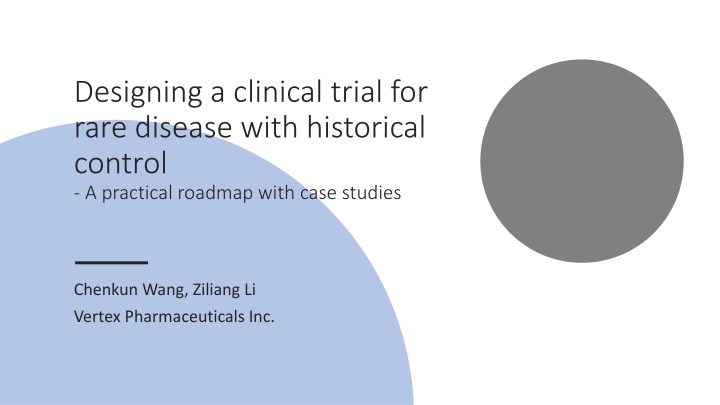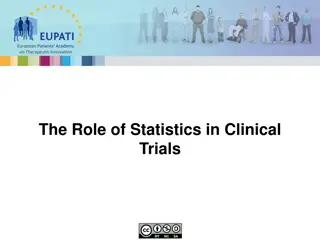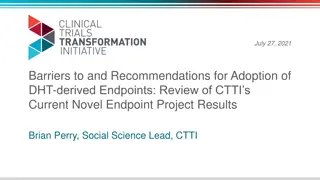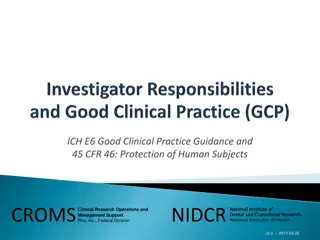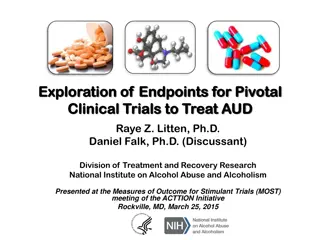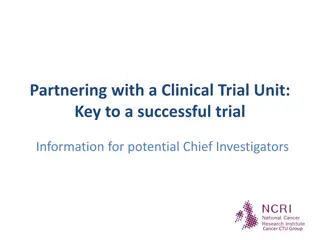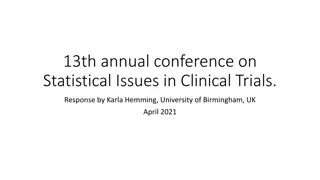Practical Guidelines for Designing Clinical Trials in Rare Diseases
This comprehensive content delves into the strategic planning of clinical trials for rare diseases, emphasizing the utilization of historical control data and the challenges associated with it. It discusses the significance of historical control in trial design, the evolving landscape of rare disease research, and the practical roadmap for implementation. Key points include the nature and extent of evidence needed, considerations for using historical control, disadvantages, and strategies to minimize them. The content also presents case studies and insights from industry experts for a well-rounded understanding of this critical aspect of clinical research.
Download Presentation

Please find below an Image/Link to download the presentation.
The content on the website is provided AS IS for your information and personal use only. It may not be sold, licensed, or shared on other websites without obtaining consent from the author.If you encounter any issues during the download, it is possible that the publisher has removed the file from their server.
You are allowed to download the files provided on this website for personal or commercial use, subject to the condition that they are used lawfully. All files are the property of their respective owners.
The content on the website is provided AS IS for your information and personal use only. It may not be sold, licensed, or shared on other websites without obtaining consent from the author.
E N D
Presentation Transcript
Designing a clinical trial for rare disease with historical control - A practical roadmap with case studies Chenkun Wang, Ziliang Li Vertex Pharmaceuticals Inc.
Historical control: not a new concept Back to historical control ? Compared to a different group of people with similar situation treated in a different manner Historical Control Randomized clinical trial was widely recognized. Accessibility to massive historical data Growth trend in rare disease Gold standard of clinical trial Remove the potential bias Produce compared groups Or compared to the same group of people previously untreated Self-control 1983 Orphan Drug Act 1950 Number of Orphan Indications Approved in the United States 1983 2018: Source: FDA. Search Orphan Drug Designations and Approvals. 2018 Sep. Available from: https://www.accessdata.fda.gov/scripts/opdlisting/oopd/
Co-leads: Rui (Sammi) Tang , Servier Pharmaceuticals DIA-ADSWG Nature and Extent of Evidence Needed for Rare Diseases (NEED) Subteam Mercedeh Ghadessi, Bayer Team members (alphabetical order): Chaoqun Mei, University of Wisconsin-Madison Chenkun Wang, Vertex Pharmaceuticals ChunQin(C.Q.) Deng, United Therapeutics Corp Kiichiro Toyoizumi, Shionogi Inc. Jeffrey Schwartz, Pfizer Joey Zhou , Q2BI Lihua Yue, Celgene Lixia Zhang, BERG health Robert Beckman, Georgetown University Rong Liu, Celgene Ziliang Li, Vertex Pharmaceuticals
A Practical Roadmap
1 Should we use HC? 2 3 4 Disadvantages of using HC Minimizing disadvantages Resources of HD Medical chart Patient registry Claim data Previous clinical trials Natural history studies
1 Should we use HC? 2 3 4 Disadvantages of using HC Minimizing disadvantages Resources of HD
1 Should we use HC? 2 3 4 Disadvantages of using HC Minimizing disadvantages Resources of HD Not randomized Population between groups are not comparable Age Age- -adjusted Death Rates for adjusted Death Rates for Heart Disease United States, 1980 United States, 1980- -2015 Heart Disease: : 2015 Rate per 100,000 standard 400 Not concurrent Improved standard care More sensitive technology 350 300 population 250 200 150 100 Data collection Lack of blinding Accuracy Missingness 50 0 Year Source: https://data.cdc.gov/NCHS/NCHS-Age-adjusted-Death-Rates-for-Selected-Major-C/6rkc-nb2q
1 Should we use HC? 2 3 4 Disadvantages of using HC Minimizing disadvantages Resources of HD Step 1 Step 2 Step 3 Step 1: At the design stage Choose high-quality historical control(s) Checklists to evaluate real-world data Flowcharts by Clinical Trials Transformations Initiative (CTTI) to evaluate registry data Design the current study closely to the selected historical control(s) Pocock s (1976) criteria Inclusion/exclusion criteria for patient population Type of study design Exact definition of the outcome Quality of study execution and management; Potential biases due to time trends
1 Should we use HC? 2 3 4 Disadvantages of using HC Minimizing disadvantages Resources of HD Step 1 Step 2 Step 3 Step 2: At the analysis stage Network meta-analysis Simulated treatment outcome Matching-adjusted indirect comparison Meta-analysis Matching based on covariates or propensity score Weighting by the inverse probability of treatment Etc. Casual inference/ observational study Bias-variance (Pocock SJ, 1976) Test-then-pool (Viele K, et al, 2014) Power prior (Ibrahim JG, et al, 2000) Meta-analytic Combined (Neuenschwander B, et al, 2010) Meta-analytic Predictive (Neuenschwander B, et al, 2010) Etc. Historical borrowing
1 Should we use HC? 2 3 4 Disadvantages of using HC Minimizing disadvantages Resources of HD Step 1 Step 2 Step 3 Step 3: Simulation and sensitivity analysis No one solution that works in all situations. The recommendation is to perform simulations as the following process:
Step One: Step One: DESIGN DESIGN Step Two: Step Two: EXECUTE EXECUTE Step Three: Step Three: FILE FILE
Disclaimers This is a biased sample of drug development programs which utilize historical data: all drug got approved Numerous factors play a role in designing/implementing a particular historical data strategy, these cases only reflect the end product that went into filing Historical data/RWD have a broad spectrum of applications, these cases just focus on using them to support approval from FDA 13
Resources of HD 1 2 Should we use HC? Based on latest cases reviewed by NEED, a variety of source of historical data were used: Chart review/database (6), Registry (6), Previous clinical trials (4), and Natural history (6) Outcome of the evaluations lead to different development pathway. Take type 1 spinal muscular atrophy (SMA) as an example Drug US Approval Year Modality Source of HC Method to utilize HC SPINRAZA 2016 Intrathecal injection Natural history Served as the control arm in a Ph2 dose-finding study ZOLGENSMA 2019 Gene Therapy Prospective Natural history study Characterized disease progression to support the pivotal study Risdiplam In development Oral Natural history Setup the efficacy threshold
HC Strategy 1+2 AMMONUL, BLINCTYO, BAVENCIO, FERRLECIT, Taf + Mek, TRISENOX, ZEPATIER, ATRYN, BALVERSA, REFLUDAN, XPOVIO Prevalence of the Indicated Disease 1/2k Rare Disease Rare Disease Strategy to utilize historical data (to compare against IMP) varies, depending on quantity and quality of the historical data. 1/10k ORFADIN, MYOZYME, ZOLGENSMA KANUMA, EXONDYS 51 1/100k STRENSIQ, ZAVESCA STRENSIQ, BRINEURA 1/1m XURIDEN CARBAGLU CEPROTIN Patients Patients Narratives Narratives Numeric Numeric Comparison Comparison Statistical Statistical Comparison Comparison HC Strategy HC Strategy
3 Disadvantages of using HC Selection / Assessment Bias and Missing Values Selection / Assessment Bias and Missing Values Selection bias Natural history study suggested improved survival overtime, the benefit is likely to be over estimated. HC group was identified post hoc, after outcome from treated and placebo groups from the randomized study were known selection criteria systematically ensure that the clinical study cohort will have longer expected OS compared to historical cohort Assessment bias performance on 6MWT can be improved by motivation in a clinical trial setting, while in real life, patients may not achieve maximal 6MWT due to concerns of failing or injury evidence is not sufficiently strong regarding the ... comparability between HC and pivotal study. FDA s efficacy assessment ignored the language domain. Missing Values The data does not include significant information such as bone marrow biopsy result, drugs involved in priori treatments, dosages and laboratory data.
4 Minimizing disadvantages Statistician s Expertise Matters Statistician s Expertise Matters Go beyond IE criteria to make historical and current cohort comparable Only 1 case (BRINEURA) where FDA specifically requested a 1:1 matched analysis, using baseline factors, as the primary analysis. However, there is an increasing trend in using statistical methods which could improve the quality of the external control based on relevant covariates (BALVERSA) Determine the right endpoint to facilitate the comparison to the IMP Objective and validated (clinical) assessment Summary measure appropriate based on the historical data, e.g., rate of decline, responder, time to event Sufficient observation period and proper index date Characterize disease progression: X (covariates) Y (outcome) Depending on the phenotype, the same (rare) disease can have predictable vs. variable disease progression, e.g., infantile- vs. late-onset Pompe Choose the right analytic approach to synthesize historical data
Summary A practical roadmap to design and analyze clinical trial for rare disease using historical (external) control A brief look at case studies related to rare disease Different strategy to utilize historical data and/or historical control Disadvantages when using HC Strategies (could have been implemented) to minimize the disadvantages Future work/topics Putting new methodologies to test Forward looking: how to conduct good natural history/observation study to generate quality evidence
